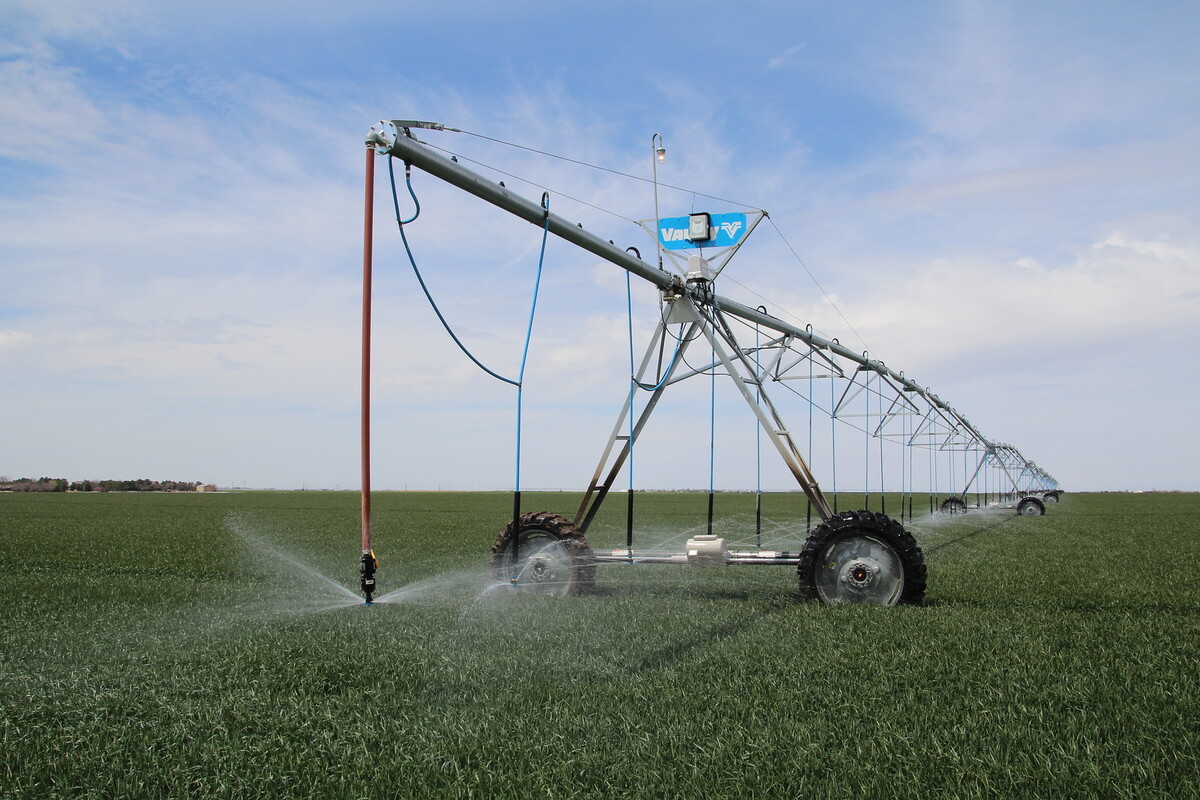Home>Gardening News and Trends>Gardening Trends>How Can Nuclear Energy Use Potentially Affect Soil Quality?


Gardening Trends
How Can Nuclear Energy Use Potentially Affect Soil Quality?
Published: February 14, 2024
Discover the impact of gardening trends on soil quality and explore how the use of nuclear energy can potentially influence it. Uncover the relationship between gardening and soil health now!
(Many of the links in this article redirect to a specific reviewed product. Your purchase of these products through affiliate links helps to generate commission for Chicagolandgardening.com, at no extra cost. Learn more)
Table of Contents
- Introduction
- Understanding Nuclear Energy
- The Potential Impact of Nuclear Energy on Soil Quality
- Factors Contributing to Soil Contamination from Nuclear Energy
- Effects of Nuclear Energy on Soil Microorganisms
- Accumulation of Radioactive Elements in Soil
- Radioactive Pollution and Soil Nutrient Availability
- Soil Remediation Strategies in Nuclear Energy Sites
- Monitoring and Regulation of Soil Quality in Nuclear Energy Industry
- Conclusion
Introduction
Welcome to the fascinating world of gardening trends! As the world becomes increasingly conscious of the environment and sustainable living, the popularity of gardening continues to soar. Whether you have a sprawling backyard or a small balcony, gardening offers a rewarding and fulfilling experience that connects us with nature.
In this article, we will explore the latest gardening trends and insights to help you stay informed and inspired in your gardening endeavors. From innovative techniques to emerging plant varieties, there is always something new and exciting happening in the world of gardening.
Gardening trends not only provide us with innovative ideas to beautify our green spaces but also shed light on important environmental considerations. As climate change becomes a growing concern, sustainable gardening practices are gaining momentum. This means incorporating organic gardening methods, conserving water, and nurturing beneficial insects and wildlife in our gardens.
Additionally, gardening can be a therapeutic and stress-relieving activity. It allows us to disconnect from our digital lives and reconnect with nature. The act of planting, nurturing, and observing the growth of plants can bring a sense of peace and tranquility. It’s no wonder that gardening is considered a popular form of mindfulness.
Furthermore, gardening is not limited to outdoor spaces. With the rise of urban living, container gardening has become increasingly popular. From herbs on windowsills to vertical gardens on balconies, even small spaces can be transformed into lush green havens.
Are you ready to delve into the world of gardening trends? Let’s explore the exciting techniques and ideas that can elevate your gardening experience, while staying mindful of the environment and accessing the therapeutic benefits of this wonderful hobby.
Understanding Nuclear Energy
Nuclear energy is a powerful and controversial form of energy production that harnesses the energy released from nuclear reactions. It involves the use of radioactive materials, such as uranium and plutonium, which undergo controlled fission or fusion reactions to generate heat. This heat is then used to produce steam, which drives turbines to generate electricity.
One of the key benefits of nuclear energy is its high energy density. A small amount of nuclear fuel can produce a significant amount of electricity, making it a viable alternative to fossil fuel-based power generation. It is also a reliable source of electricity, as nuclear power plants can operate continuously for extended periods without interruption.
However, the use of nuclear energy raises several concerns, particularly related to the potential environmental and health impacts. One major concern is the management and disposal of radioactive waste generated during the operation of nuclear power plants. This waste, which remains hazardous for thousands of years, requires careful handling and disposal to prevent contamination of the environment and human exposure to radiation.
Another significant concern is the risk of nuclear accidents. While modern nuclear power plants are designed with multiple layers of safety systems, accidents can still occur, as demonstrated by events such as the Chernobyl and Fukushima disasters.
It’s important to note that the impact of nuclear energy on soil quality can vary depending on several factors, including the design and safety measures of the power plant, the handling and disposal of radioactive waste, and the effectiveness of monitoring and regulation. Understanding these factors is crucial in assessing and mitigating the potential risks associated with nuclear energy.
As we delve deeper into the impact of nuclear energy on soil quality, it is essential to approach the topic with an objective and informed perspective. By understanding the complexities and potential risks involved, we can better address the challenges and work towards implementing sustainable practices that minimize environmental impact.
The Potential Impact of Nuclear Energy on Soil Quality
Nuclear energy can have significant effects on soil quality due to the potential release of radioactive materials into the environment. Radiation from radioactive elements can lead to soil contamination, adversely affecting soil fertility and the overall health of ecosystems.
One of the primary concerns is the deposition of radioactive particles onto the soil surface. These particles can come from nuclear accidents, such as reactor meltdowns or explosions, or from routine operations of nuclear power plants. When these particles settle on the soil, they can emit radiation and contaminate the surrounding area.
Radioactive contamination can alter soil pH levels, disrupt nutrient cycling, and inhibit the beneficial activities of soil microorganisms. This can lead to reduced plant growth and productivity, as well as potential health risks for humans and animals that consume contaminated plants or organisms from the affected area.
Additionally, radioactive elements released into the environment can undergo bioaccumulation in the soil. Certain plants have the ability to uptake and store radioactive elements, which can then be transferred to the organisms that consume them, including humans. This bioaccumulation poses long-term health risks and can result in the spread of contamination beyond the immediate vicinity of the nuclear energy site.
It is important to note that the impact of nuclear energy on soil quality is not limited to the immediate vicinity of nuclear power plants. Airborne transport of radioactive materials can lead to contamination of remote areas as well. This emphasizes the need for comprehensive monitoring and regulation to ensure the safety of soil and ecosystems across a broader geographical range.
The potential impact of nuclear energy on soil quality necessitates stringent safety measures and environmental assessments. From the construction and operation of nuclear power plants to the management of radioactive waste, it is crucial to prioritize the protection of soil resources and ecosystem health.
As we continue to explore the potential impact of nuclear energy on soil quality, it is essential to remain informed and proactive in promoting sustainable practices and mitigating the risks associated with radioactive contamination. Through robust monitoring, effective regulation, and the adoption of safe handling practices, we can minimize the potential harm to soil ecosystems and safeguard the long-term health of our planet.
Factors Contributing to Soil Contamination from Nuclear Energy
Soil contamination from nuclear energy can occur through various pathways and is influenced by several factors. Understanding these factors is essential in assessing the potential risks and implementing appropriate measures to prevent or mitigate soil contamination.
One significant factor contributing to soil contamination is nuclear accidents. Accidents like reactor meltdowns or explosions can release radioactive materials into the environment, including the soil. These accidents can have catastrophic consequences, as witnessed in events like the Chernobyl and Fukushima disasters, where large areas of land were contaminated with radioactive substances.
Aside from accidents, routine operations of nuclear power plants can also contribute to soil contamination. Gaseous emissions and liquid effluents containing radioactive isotopes can be released into the atmosphere or discharged into water bodies. These emissions and effluents may eventually come into contact with the soil, leading to contamination.
Transportation and mishandling of radioactive waste can also pose a risk of soil contamination. Improper storage, packaging, or disposal of radioactive waste can result in leakage or spillage, allowing radioactive materials to seep into the soil. It is crucial to have strict protocols and regulations in place for the safe handling and management of radioactive waste to minimize the risk of soil contamination.
Moreover, the proximity of nuclear power plants to water bodies can increase the risk of soil contamination through the contamination of groundwater. Radioactive materials can leach into the soil through water runoff or infiltration. This can lead to long-term contamination of soil and potentially impact surrounding ecosystems.
The nature of the surrounding environment and soil composition also plays a role in soil contamination. Some soil types, such as sandy soils, have a higher permeability, allowing radioactive contaminants to penetrate more easily. On the other hand, clay soils have higher retention capacities and can bind and trap radioactive elements, reducing their mobility and potential for contamination.
Overall, a combination of factors, including accidents, routine operations, mishandling of radioactive waste, proximity to water bodies, and soil composition, can contribute to soil contamination from nuclear energy. By understanding these factors, we can develop strategies and protocols to minimize the risk of contamination and protect soil quality and ecosystem health.
Effects of Nuclear Energy on Soil Microorganisms
Soil microorganisms play a crucial role in maintaining soil fertility and supporting healthy ecosystems. However, the release of radioactive materials from nuclear energy activities can have adverse effects on these microorganisms, disrupting their populations and functions.
Exposure to radiation can cause DNA damage and mutations in soil microorganisms, leading to impaired reproductive capabilities and reduced microbial diversity. This can result in the loss of essential ecosystem services provided by microorganisms, such as nutrient cycling, organic matter decomposition, and disease suppression.
Furthermore, some microorganisms possess enzymatic activities that contribute to the detoxification of contaminants in soil. However, exposure to radiation can compromise these enzymatic functions, reducing the soil’s ability to break down and eliminate pollutants.
In addition to direct effects, the presence of radioactive elements in soil can indirectly impact soil microorganisms. Radioactive pollution can alter soil pH, affecting microbial community structure and function. Changes in pH can favor certain microbial populations while inhibiting others, leading to imbalances in soil microbial communities.
Radioactive contamination can also influence soil nutrient availability, which can indirectly impact soil microorganisms. Some radioactive isotopes can interfere with the uptake and cycling of essential nutrients, resulting in nutrient imbalances that can affect microbial growth and activity. These imbalances can have cascading effects on plant health and overall ecosystem functioning.
It is important to note that the effects of nuclear energy on soil microorganisms are complex and can vary depending on factors such as the type and intensity of radiation, exposure duration, soil characteristics, and the sensitivity of microorganisms. While some microorganisms may be more resistant to radiation, others may be more susceptible.
To mitigate the potential detrimental effects of nuclear energy on soil microorganisms, it is crucial to employ strategies that minimize contamination, such as proper waste management, containment measures, and effective soil remediation techniques. Supporting microbial communities through organic practices, promoting soil biodiversity, and restoring soil health can also help to reestablish the balance and functionality of soil microorganisms in affected areas.
By understanding the effects of nuclear energy on soil microorganisms, we can make informed decisions and develop practices that protect and promote the health and functionality of these essential components of soil ecosystems.
Accumulation of Radioactive Elements in Soil
Radioactive elements released from nuclear energy activities can accumulate in soil through various processes, posing long-term risks to soil quality and ecosystem health. Understanding the mechanisms of accumulation is essential in assessing and mitigating the potential impacts of radioactive contamination.
One way that radioactive elements accumulate in soil is through deposition. During nuclear accidents or routine operations, radioactive particles can be carried through the air and settle on the soil surface. These particles can originate from radioactive gases, ashes, or dust released into the atmosphere.
Once deposited, these radioactive particles can remain in the upper layers of the soil or be transported deeper through soil erosion or leaching processes. In some cases, soil erosion can result in the redistribution of contaminated soil particles to other areas, potentially expanding the scope of contamination.
Another mechanism of accumulation is through the uptake of radioactive elements by plants. Certain plants have the ability to absorb and accumulate radioactive isotopes from the soil through their roots. These isotopes can then become incorporated into the plant’s tissues, including leaves, stems, and fruits.
When animals graze on plants or consume plant-based products, such as milk or meat, they can also accumulate radioactive elements in their bodies. This process, known as bioaccumulation, can lead to the transfer of contamination through the food chain.
The accumulation of radioactive elements in soil can have significant consequences for ecosystem health. Radioactive isotopes can emit radiation, which can affect the physiology and reproductive capabilities of plants and animals. Additionally, long-term exposure to radioactive elements can cause genetic mutations and increase the risk of cancer or other health issues in organisms.
The extent of accumulation and the potential risks associated with radioactive contamination in soil depend on several factors, including the type of radioactive isotope, its half-life, soil composition, and environmental conditions. Some radioactive elements may have longer half-lives, resulting in persistent contamination, while others may decay more rapidly.
Efforts to mitigate the accumulation of radioactive elements in soil include the implementation of containment measures and strict waste management protocols. Adequate disposal of radioactive waste and the proper monitoring of plants and animal products can help prevent the spread of contamination and reduce the risks to soil and ecosystem health.
As we work towards a cleaner and safer future, it is crucial to continue research and monitoring on the accumulation of radioactive elements in soil. By understanding the mechanisms and patterns of accumulation, we can develop more effective strategies to mitigate the risks and ensure the preservation of soil quality and ecosystem integrity.
Radioactive Pollution and Soil Nutrient Availability
The presence of radioactive elements resulting from nuclear energy activities can have detrimental effects on soil nutrient availability, disrupting the delicate balance of essential elements in the soil. This can impact the growth and health of plants, leading to cascading effects on soil ecosystems.
Radioactive pollution can interfere with the uptake and cycling of nutrients in the soil. Some radioactive isotopes have chemical properties that allow them to behave similarly to essential nutrients. As a result, plants may absorb these radioactive elements in place of the necessary nutrients, leading to nutrient imbalances.
For example, radioactive isotopes of cesium can mimic potassium, which is an essential nutrient for plant growth. As a result, plants may take up these radioactive isotopes in their root systems, compromising their ability to absorb and utilize potassium effectively. This can lead to potassium deficiency in plants and subsequent stunted growth and reduced crop yields.
The presence of radioactive elements can also impact the beneficial microbial communities in the soil that play a crucial role in nutrient cycling. Soil microorganisms, such as mycorrhizal fungi and nitrogen-fixing bacteria, contribute to nutrient availability for plants. However, exposure to radiation can disrupt the populations and activity of these beneficial microbes, compromising nutrient cycling processes.
Furthermore, radioactive pollution can alter soil pH levels, which greatly influences nutrient availability. Changes in pH can result in the solubility of certain nutrients, making them more or less available to plants. This can lead to imbalances in nutrient uptake and availability, affecting the overall health and productivity of plants.
The effects of radioactive pollution on nutrient availability in soil can have long-term impacts on plant communities. Nutrient deficiencies can weaken plant resistance to pests and diseases, making them more susceptible to damage. Additionally, nutrient imbalances can affect the quality and nutritional value of crops, impacting human and animal health.
Reducing the impact of radioactive pollution on soil nutrient availability requires proper waste management, containment measures, and soil remediation strategies. These approaches aim to minimize the release of radioactive elements into the environment and restore nutrient balance in contaminated soils.
Implementing sustainable soil management practices, such as organic fertilization and the use of soil amendments, can also help improve nutrient availability and overcome imbalances caused by radioactive pollution. Additionally, promoting soil biodiversity and fostering healthy soil microbial communities can enhance nutrient cycling processes.
By addressing the effects of radioactive pollution on soil nutrient availability, we can ensure the long-term fertility and productivity of soils, promoting sustainable agriculture and ecosystem health.
Soil Remediation Strategies in Nuclear Energy Sites
Soil remediation plays a crucial role in restoring and rehabilitating contaminated soil in nuclear energy sites. It involves the implementation of various strategies and techniques to reduce the concentration and mobility of radioactive elements, ultimately ensuring the long-term safety of the environment and surrounding communities.
One commonly used soil remediation technique is soil washing. This method involves the physical or chemical separation of contaminated soil from the radioactive elements. Through a combination of water-based extraction and chemical treatments, soil washing can effectively remove or reduce the concentration of radioactive contaminants, allowing for the reuse or safe disposal of the decontaminated soil.
Another approach is soil vapor extraction, which focuses on removing volatile contaminants from the soil by creating a vacuum or negative pressure. This technique is particularly effective for removing radioactive gases or volatile organic compounds that may have permeated the soil.
Phytoremediation is an innovative and sustainable soil remediation method that utilizes plants to remediate contaminated soil. Certain plants, known as hyperaccumulators, have the ability to absorb and accumulate high levels of radioactive elements from the soil. These plants can be grown in contaminated areas and then harvested and disposed of, effectively removing the radioactive contaminants from the soil.
Bioremediation is another biological remediation method that relies on microorganisms to degrade or transform contaminants in the soil. By creating favorable conditions and introducing specific microorganisms, bioremediation can enhance the natural processes of contaminant breakdown and reduce the concentration of radioactive elements.
In-situ solidification and stabilization techniques involve the treatment of contaminated soil directly in place. Solidification techniques involve the addition of binders or stabilizers to reduce the mobility of radioactive elements, while stabilization techniques aim to chemically or physically alter the contaminants to make them less toxic or bioavailable.
It is important to note that the selection of soil remediation strategies depends on several factors, including the type and concentration of radioactive elements, soil characteristics, the extent of contamination, and regulatory requirements. A combination of multiple techniques may be necessary to achieve the desired level of remediation.
Additionally, thorough monitoring and verification of the effectiveness of soil remediation efforts are essential. Periodic soil sampling and analysis should be conducted to assess the progress of remediation and ensure that the site meets the required standards for contaminant levels.
Soil remediation in nuclear energy sites is a complex and challenging task. It requires expertise, careful planning, and collaboration among various stakeholders, including scientists, engineers, regulatory agencies, and local communities. Through the implementation of effective soil remediation strategies, we can mitigate the long-term risks associated with radioactive contamination and restore the health and integrity of the soil in affected areas.
Monitoring and Regulation of Soil Quality in Nuclear Energy Industry
Monitoring and regulation of soil quality are vital aspects of ensuring the safe operation of the nuclear energy industry and protecting the environment. These measures help to assess the impact of nuclear activities on soil ecosystems, detect potential contamination, and establish appropriate remediation strategies.
Monitoring programs are designed to regularly assess soil quality parameters in and around nuclear energy sites. Soil samples are collected and analyzed to determine the concentration of radioactive elements, as well as other indicators of soil health, such as pH levels, nutrient content, and microbial activity.
The frequency and scope of soil monitoring depend on various factors, including the type of nuclear activity, the proximity to sensitive areas, and regulatory requirements. Monitoring may be conducted on-site, in surrounding areas, and even in locations far from the nuclear facility to detect any potential dispersion of radioactive materials.
The establishment of regulatory frameworks and guidelines is crucial for effective soil quality management in the nuclear energy industry. Regulatory agencies set standards and requirements for soil monitoring, remediation, and waste management practices to ensure compliance with safety and environmental standards.
These regulations may include limits on the allowable concentration of radioactive elements in soil, protocols for soil sampling and analysis, guidelines for waste disposal and containment, and requirements for reporting and disclosure of monitoring results.
Regulatory agencies also play a crucial role in overseeing the implementation of soil remediation efforts. They review and approve remediation plans, conduct inspections, and ensure that remediation activities are carried out in accordance with established guidelines. They may also enforce penalties and sanctions for non-compliance.
International organizations, such as the International Atomic Energy Agency (IAEA), contribute to the development of standards and guidelines for soil quality monitoring and regulation in the nuclear energy industry. These organizations foster collaboration and information sharing among countries to promote best practices and ensure a high level of environmental protection.
Public participation and transparency are significant components of monitoring and regulation in the nuclear energy industry. Regular communication with the public, including local communities, provides information about soil monitoring results, remediation efforts, and regulatory processes, fostering trust and accountability.
Through robust soil quality monitoring and effective regulation, the nuclear energy industry can minimize the potential impact on soil ecosystems, prevent contamination, and promptly address any issues that arise. These measures ensure the protection of the environment, public health, and the sustainable operation of nuclear facilities.
Conclusion
Gardening trends continue to evolve and offer exciting possibilities for both experienced gardeners and newcomers to the hobby. As society becomes more focused on sustainability and environmental stewardship, incorporating organic practices, conserving water, and fostering biodiversity in our gardens have become paramount.
Nuclear energy, while a powerful source of electricity, also brings challenges in terms of potential soil contamination. Understanding the impact of nuclear energy on soil quality is essential in addressing these concerns and implementing effective mitigation strategies.
Factors contributing to soil contamination from nuclear energy include accidents, routine operations, mishandling of radioactive waste, proximity to water bodies, and soil composition. By addressing these factors and implementing strict regulations, the risk of soil contamination can be minimized.
The potential impact of nuclear energy on soil quality extends to soil microorganisms, nutrient availability, and the accumulation of radioactive elements. Strategies such as soil remediation, phytoremediation, and bioremediation can help restore and rehabilitate contaminated soil, ensuring the long-term safety of the environment.
Monitoring and regulating soil quality in the nuclear energy industry are critical for assessing contamination, implementing remediation efforts, and providing public transparency. Through regular soil monitoring, diligent regulation, and public involvement, potential risks can be identified and managed effectively.
Gardening trends and nuclear energy may seem like contrasting topics, but they both highlight the importance of environmental awareness and sustainable practices. As we explore innovative gardening techniques and strive for a cleaner energy future, it is crucial to prioritize the health and well-being of our soil ecosystems.
By staying informed about gardening trends and the potential impact of nuclear energy on soil quality, we can make informed choices in our gardening practices and advocate for responsible energy production. Let’s continue to nurture our gardens while safeguarding the planet and its precious resources.








